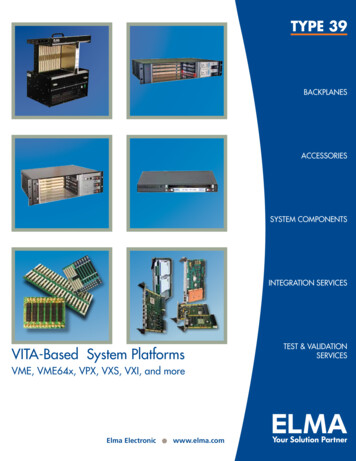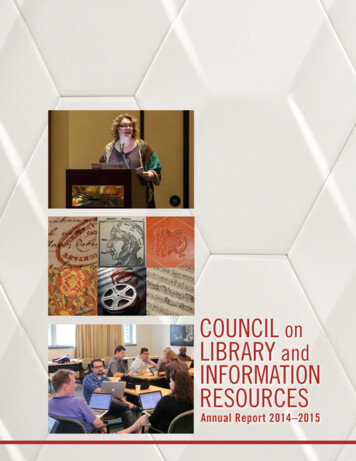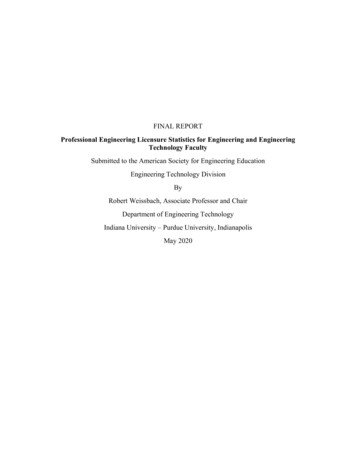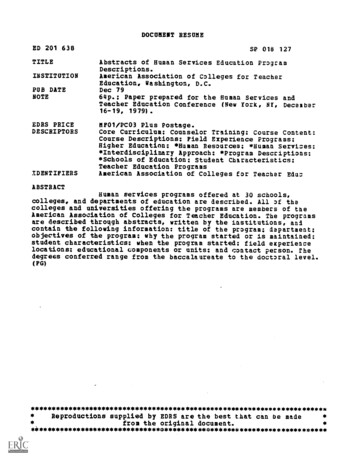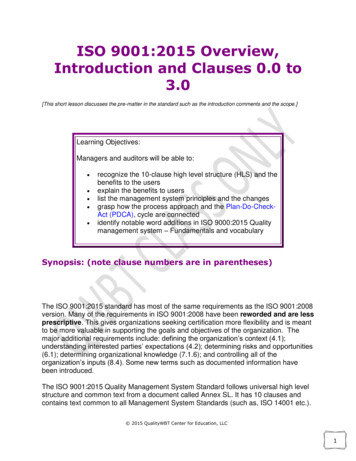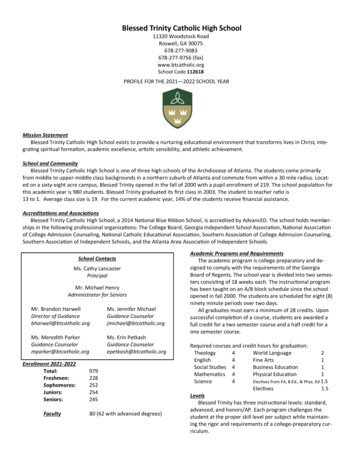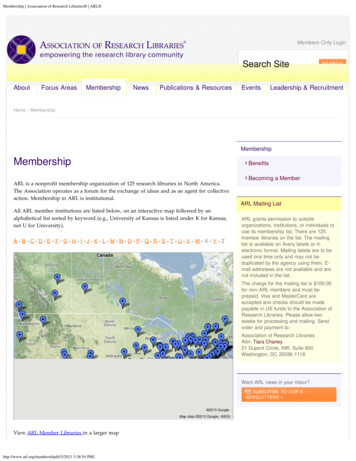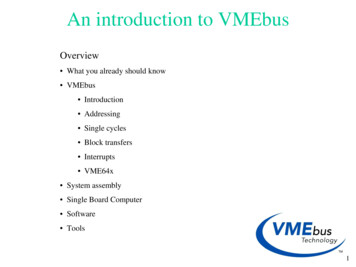
Transcription
An introduction to VMEbusOverview What you already should know VMEbus Introduction Addressing Single cycles Block transfers Interrupts VME64x System assembly Single Board Computer Software Tools1
What you already should know C( ) programming use of pointers signals data types (char, short, int) use of C methods Linux CVS / CMT Makefiles gdb Shared libraries Usually the environment variable LD LIBRARY PATH tells thelinker where to find shared libraries Handling drivers General operation (cd, ls, mkdir, etc.)2
VMEbus mechanicsVMEbus cards exist in 3 standard heights: 3U, 6U and 9UDefinition: 1U 1.75 inchIn 6U and 9U systems there can be transition modules installed on the rear side ofthe backplane. Transition modules do not connect to VMEbus but just to theVMEbus module on the opposite side of the backplane via the user defined pins ofthe J0, J2 and J3 connectors3
VMEbus mechanics (2)BackplaneP1 J1P0 J0BackplaneP2 J26U module6U transitionmodule3U moduleBackplaneP1 J1P0 J0P2 J29U moduleP3 J39U transition moduleP1 J14
VMEbus mechanics (3)Example: 6U VME64x moduleAlignment pinIncompatible with certain old crates5 row P1 connector160 pins used for VMEbus40 kgInsertion force(415 pins * 1 N)P0 connectorUsed for PMC I/OIncompatible withcertain crates(Jaux, VME64xP)Injector / extractor handlesPush red buttonDischarge strip5 row P2 connector32 pins used for VMEbusOther pins user defined (e.g.for transition modules)5
VMEbus crates21 slot 9U crate(with 6U section)for 19” racks21 slot 6U cratefor 19” racks There are different types of power supplies (5V, / 12V, 3.3V, 48V)mounted locally or remote The fan tray unit allows to monitor parameters like voltages, currents, fanspeed, temperature (Some) crates can be controlled by a field bus (CAN) ATTENTION: The EMC gasket to the left of slot 1 may damage yourVMEbus cards6
VMEbus BackplaneBG0J1BG1Daisy chainjumpers (onlyon some oldbackplanes)J0BG2BG3IACKJ2J3 (9Ucratesonly)Slot 1Front view6U VME64x backplane7
VMEbus basics Electrical properties Protocol Byte ordering–––––All lines use TTL levelsLow 0 . 0.6 VHigh 2.4 . 5 VAddress, address modifier and data lines are active highProtocol lines are active low– Asynchronous with 4 edge handshaking.– The duration of a VMEbus cycle depends on the speed of the master andthe slave– VMEbus is big endian. It stores the most significant byte of a word at thelowest byte address (0x0)– PCI and Intel CPUs are little endian. They store the most significant byteof a word at the highest byte address (0x3)– Most VMEbus masters (e.g. VP110) have automatic byte swapping logic8
VMEbus basics(2) Types of common modules (physical and logical)– Master A module that can initiate data transfers– Slave A module that responds to a master– Interrupter A module that can send an interrupt (usually a slave)– Interrupt handler A module that can receive (and handle) interrupts (usually a SingleBoard Computer)– Arbiter A piece of electronics (usually included in the SBC) that arbitratesbus access and monitors the status of the bus. It should always beinstalled in slot 1 of the VMEbus crate9
VMEbus basics(3) Main types of data transfers– Single cycles Transfer 8, 16 or 32 bits of data (typically) under the control of the CPU on the master Typical duration: 1 us– Block transfer (DMA) Transfer any amount of data (usually 32 or 64 bit at a time) under the control of a DMAcontroller (CPU independent) Data is transferred in bursts of up to 256 (D32) or 2048 (D64) bytes Typical duration: 150 ns per data word– Interrupts Used typically by slaves to signal a condition (e.g. data available, internal error, etc.) Can (in principle) have 7 priorities The interrupter provides an 8 bit vector on request of the interrupt handler to identifyitself ROAK (Release on Acknowledge) or RORA (Release On Register Access)10
VMEbus protocolWhy do I have to understand how the protocolworks if I am not designing cards? Some designers make mistakes and their VMEbus cards do not work at allor fail in combination with certain other cardsDebugging VMEbus traffic by S/W (printf(), gdb, etc.) is difficult or evenimpossibleA great help for fixing such problems are VMEbus analyzersA VMEbus analyzer also tells you if you are really executing the desiredtypes of cycles (D8, D16, D32, etc.)In order to understand the output of such an analyzer you have to havesome knowledge of the protocol11
Important signalsNameDescriptionBBSY*Bus Busy. Once a master has been granted the bus it drives BBSY*. As long asBBSY* is asserted no other master can get the busA[31.1]Address lines (can carry data in D64 multiplexed transfers)D[31.0]Data linesAM[5.0]Address modifier. Defines the number of valid address bits and cycle typeDS0* and DS1*Data strobes. Tell the slave when the master is ready. Also encode the numberof bytes to be transferredLWORD*Contributes to the definition of the transfer size and carries data in MBLTcyclesAS*Address Strobe. Tells the slaves when the address on the bus is validWRITE*Defines the direction of the data transferDTACK*Data acknowledge. Used by a slave to tell the master that it has read / writtenthe dataBERR*Bus error. Used by slaves or arbiters to signal errorsIRQ1* . IRQ7*Interrupt request lines. Asserted by the interrupterIACK*Interrupt acknowledge. Used by the interrupt handler to retrieve an interruptvector from the interrupter12
Arbitration Before a master can transfer data it has to request the bus. It does this byasserting one of the four bus request lines– The lines (BR0, BR1, BR2 and BR3) can be used to prioritize requests in multi master systems The arbiter (usually in slot 1) knows (by looking at the BBSY line) if the bus isbusy or idle. Once it is idle it asserts one of the four Bus Grant out lines(BGOUT 0.3)If a master detects a 1 on the BGIN line corresponding to its BR it claims thebus by asserting BBSY (otherwise it passes BGIN on to BGOUT to close thedaisy chain)Slot NBR*Slot N 1BGINBG*BGOUTBBSY*Color code: Arbiter Master13
Arbitration (2) The arbiter can use different schemes: PRI (prioritybased), RRS (round robin)– Not an issue for single master systems If two masters use the same bus request level the onecloser to slot 1 inherently has a higher priority (because itdetects BGIN first) Modern masters support “fair arbitration”. I.e. they delaytheir bus request if other masters are requesting the bus atthe same level A master may get stuck if the BG daisy chain is not closed14
Addressing The VMEbus backplane has 31 address lines: A01.A31There is no A00 address line on the backplane. This information isencoded in the DS0/1 protocol lines A slave is selected by two criteria:– Address (usually 16, 24 or 32 valid bits)– Address modifier (6 bits). It defines: The number of valid address bits The access mode (user/supervisor, program/data, CR/CSR) The transfer type (single cycle or block transfer) Typically slaves respond to only one address width (A16, A24 or A32;read the manual of the slave) but may allow both single cycles and blocktransfers The base address of a slave can be set: Mechanically: on board Jumpers, DIP switches By S/W: VME64x geographical addressing, CR/CSR15
Addressing protocol First the master drives AM, Address and LWORD*. Then it waits 35 ns andfinally drives AS* to validate the informationThe slave has to decode the address information within 40 ns (even thoughmost masters keep AS* asserted much longer)The master does not know if a slave has accepted the address information. Itcontinues with the data transfer until it either receives a DTACK* or a BERR*If two or more slaves believe to be addressed you have a problem dvalidThe timing parametersmentioned here are two ofabout 50 in the VMEbusstandard. The standardalso distinguishes masterand slave timing (busskew)AS*35 ns 40 nsColor code: Master16
Single cyclesExample: (Simplified) write 23451: Master drives address and AMcode. Then it asserts AS2: Master puts data on the bus. Then itasserts DS3: Slave latches data and drivesDTACK4: Master removes DS5: Slave removes DTACK6: Master releases Address, AM anddata lines. Then it releases ASBERR*Color code: Master Slave Arbiter17
Single cycles (2) The number of bytes to be transferred (1, 2 or 4) is encoded in theDS0, DS1 and LWORD protocol lines Remember that some slaves support only certain data widths (e.g. D8and D16 but not D32) The VMEbus address should be aligned to the data size– Reading a D32 word e.g. from address 0x000003 may not be a good idea VMEbus also supports (rarely used) read modify write cycles (usefulfor semaphores) Remember that VMEbus is big endian. Example:AddressActionResult0x00000000D32 write 0x11223344 0x00000000D32 read0x112233440x00000000D8 read0x110x00000003D8 read0x4418
Example: D32 writeBlock ACK The Block transfer protocol is based on the single cycle protocolThe address lines on the backplane do not change state during the transfer. Bothmaster and slave use internal counters to keep track of the addressAs the address lines are not used they can carry data: 64 bit multiplexed DMA.In this case the slave uses DTACK for two purposes:– Directly after AS being asserted to acknowledge the address– After each assertion of DS to acknowledge the dataColor code: Single cycle protocol – block transfer19
Block transfers (2) A master must not cross a 256 bytes (D32) or 2048 bytes (D64) addressboundary respectively without releasing AS (transparent to the user)– This is to give other masters a chance to acquire the bus before too long Reading out single address FIFOs is not foreseen by the standard and requiresspecial mastersDesigning a slave that terminates a block transfer from a FIFO with a buserror is legal but bad practice. It does not always work with the TundraUniverseVMEbus interface chips may require a relative alignment of the VMEbus andlocal (PCI) addresses– In case of the Tundra Universe the VMEbus and PCI addresses must be 8 bytealigned with respect to each other Contiguous buffers– Memory obtained with malloc() may be fragmented. Most DMA controllers,however, need contiguous buffers– Contiguous buffers are provided by special drivers (e.g. ATLAS: cmem rcc)based on kernel functions (get free pages) or extensions of the Linux kernel(BigPhysArea)20
VMEbus typical performance Being a handshaked, asynchronous protocol there is no fixed transfer rate suchas for e.g. RS232. The timing parameters (see VMEbus standard) however setan upper limit.Single cycles: Typical performance 1 µs per transfer– D8 1 MB/s– D16 2 MB/s– D32 4 MB/s Write posting decouples PCI and VMEbus cycle. This increases theperformance to 10 MB/s for D32Block transfers– D32 20.25 MB/s (theoretical: 40 MB/s)– D64 40.50 MB/s (theoretical: 80 MB/s)21
Bus errors In VMEbus errors can occur under two conditions There is no standard way for the delivery of a BERR from the VMEbusinterface to the CPU of the master– A slave has been addressed but is incapable of performing the requested transfer. Inthis case the BERR signal is issued by the slave and reaches the master within a fewµs.– The master has issued an address that no slave recognizes. Such cycles getterminated by the bus monitor (arbiter) by asserting BERR after a programmabledelay (typical values are 16 or 256 µs)– On PowerPCs BERR is typically converted directly to a non maskable interrupt andthen converted to the SIGBUS signal by the operating system– Certain Intel based SBC ignore bus errors– Other Intel based SBCs convert it to a regular PCI interrupt. This interrupt istypically handled by the VMEbus driver and converted to the SIGBUS signal22
Interrupts VMEbus provides 7 interrupt levels ( bus lines) to prioritize interruptsEach interrupter can use any levelThere must only be one interrupt handler for each levelThe interrupt handler uses (under H/W control) a special type of single cycle (IACKcycle) to obtain an 8 bit vector from the interrupter. This vector (set by jumpers orS/W) must be unique (within the crate) and identifies the source of the interruptThere are two types of interrupters:– ROAK (preferred) The IACK cycle clears the interrupt– RORA The interrupt is cleared by an additional register access (single read or write cycle) Typically an interrupt gets handled by the H/W in a few µs (once the VMEbus is free).There can be additional (possibly large) S/W overheads depending on the operatingsystem used and the state of the CPUIf two interrupters are active at the same time and on the same level the one closer toslot 1 will be serviced first (IACK daisy chain)Slot NSlot N 1IACKINIACKOUT23
VME64x VME64x is a set of extensions to the VMEbus standard made in 1997Most features are optional and fall into one of four categories:– Mechanics 5 row P1/J1 and P2/J2 connectorsJ0/P0 connectorAlignment pinEMC gasketsInjector / extractor handlesDischarge stripsCard keysSolder side covers– Plug and play Geographical addressing (access a module by its slot number) CR/CSR space: Standardised registers for the automatic configuration of a module (baseaddress(es), interrupt vector(s), etc.)– Power 3.3 V and 48 V Additional 5 V– 2eVME Protocol: A rarely used way of speeding up block transfers (theoreticalbandwidth: 160 MB/s)24
CR/CSR space access and geographicaladdressing “Classic” VMEbus slaves use on board jumpers or switches for theinitialization of the base address and the interrupt vectors The VME64(x) standard proposes a S/W based mechanism (plug and play)The basic principles are:– Each slave has a special window of 512 kB consisting of a Configuration ROM(CR) and a Control and Status Register (CSR) section– Access to this window is in A24 mode with AM 0x2f only– The address of that window (BAR) is either set by jumpers (VME64) or derivedfrom the slot number (geographical addressing, VME64x) with the formula:address slot# * 0x80000– The CR/CSR space contains many (mostly optional) features to specify andcontrol the functions of a slave board– Slave boards are identified by a manufacturer board ID stored in the CR.Board IDs have to be unique (http://cern.ch/boardid)– The most important CSR space registers are the eight ADER registers. They areused to define the base address(es) of the main function(s) of the slave.25
2eSST 2eSST 2 edge Source Synchronous TransferA recent (1999) addition to the VME64x standardIt defines a synchronous protocol for VMEbus block transfersThree transfer speeds are defined: 160, 267 and 320 MB/s (8 bytes @20, 33.3 and 40 MHz) Allows for data broadcast and multicast Works only reliably on high quality backplanes (incident waveswitching) and special (Texas Instruments) driver chips There exist (so far) only a hand full of VMEbus modules built to thisstandard26
The VMEbus single board computer Usually this is the only master and interrupt handler in the crateIt often also provides the arbiter functionality (and should therefore beinstalled in slot 1, despite what is said about cooling)It behaves like a normal PC–––– Operating system: Linux, (LynxOS, Windows)Development tools: gcc, g , gdbEnvironment: Shell, Xterm, vi, emacsAccessed via: RS232, Ethernet, (VGA)It interfaces to VMEbus via a PCI device– Typically Tundra Universe– Depending on the model and the S/W used it has to be configured in the BIOS or atstart up by special programs The PowerPC CPU does instruction reordering. Use the “eieio” assemblerinstruction to enforce the proper order of executionSome SBCs can be equipped with mezzanines (PMC, IP) but this is anotherstory27
The VP110 SBC This SBC (manufactured by Concurrent Technologies) is the default SBC forATLAS ROD cratesRecently ALICE has decided to use it for most VMEbus systemsYou can rent this processor from the El. PoolCPUPentium III @ 800 MHzRAM512 MBVMEbus interfaceTundra UniversePMC sitesTwo. 32 or 64 bit, 33 or 66 MHz, (can be configured for 5V or 3.3V signaling)Mass storageConnection of IDE hard disks and floppy drives possible via P2 adapter board(requires 5 row VME64x backplane) A hard disk can also be installed on board. This takes one of the PMC slotsNetwork interfaceTwo channels, 10 / 100 Mbit/s, RJ45 on front panel (based on the 82559ERinterface chip)MechanicsVME64x compliant: 5 row P1 and P2, P0 (optional), front panel withalignment pin and injector / extractor handles (alternative solution for 3 rowVME backplanes exists), solder side coverTerminal connectionRS232 via front panel RJ45 connector, no VGA / mouse / keyboard (can beadded by additional PMC module)28
Other VMEbus masters and interfaces PC to VMEbus interfaces– Available from several manufacturers– A set typically consists of a PCI card, a VMEbus card and a cable (copper oroptical fiber)– Example: National Instruments MXI 2 Allows to control several VMEbus crates from one PC Library support for LabView and standard C VMEbus repeaters– Allows a master in crate 1 to access a slave in crate 2– A set consists of two VMEbus cards and a cable– There is usually a performance penalty VMEbus to CAMAC interface– Allows a master in a VMEbus crate to control a CAMAC crate– A set consists of a VMEbus slave, a CAMAC crate controller and a cable You can get such interfaces form the CERN El. Pool29
Subsystem busesThe P0, P2 and P3 connectors have a number of user defined pins. They can beused to implement specialized communication channels independently from theVMEbus protocol. Examples: VSB (VME Subsystem Bus) VXS Custom P3– Obsolete.– Provides a 32 bit bus for up to 8 adjacent cards.– Was used to interface to FASTBUS– A recent addition to the standard.– It allows each VMEbus card to connect to a switch fabric.– Initially it uses the Ethernet protocol but other technologies (e.g. Infiniband)are being discussed– In 9U crates the P3 is totally user defined.– Special backplanes are possible too30
System integration Find the right crate for your modules Find out if your crate still has BG/IACK jumpers Card handling and insertion Cooling Address lay out– J0 / Jaux incompatibility– VME64x (alignment pin, geographical addressing)– Rule: Each slot must be equipped with 1 card or 5 jumpers– Attention: Jumpers may be on either side of the J1 connector depending on backplane type– VMEbus cards can be sensitive to electrostatic discharge. Take precautions– Never add or remove a card if the crate is switched on– Depending on the type of module the insertion force is between 20 and 50 kg. Check twicethat the card really has been inserted properly!!– Do not trust LEDs on the front panel. On certain (VME64x) cards the power pins are longerthan the protocol pins.–––––Avoid installing CPUs in the leftmost or rightmost slot (there are special arbiter modules)Leave one or two slots empty between cards, if possibleClose the front of the crate with blind panelsCheck the fan speedUse programs (e.g. thermo) to read the temperature of the SBC– Check that the address windows of the slave modules do not overlap– Try to map similar slaves (e.g. A32, A24) to consecutive addresses31
VMEbus S/W(Linux) Drivers In (almost) all cases access to the VMEbus is via a device driverThe driver allows to use the VMEbus in multi processing environmentsIn some drivers the read() / write() functions are used to access the VMEbusMost transactions are implemented by ioctl() functionsInterrupts are handled by the driver and signalled to the user application e.g.by means of signals or semaphoresThe drivers typically provide DMA request lists. A block transfer maytherefore not take place immediately but be delayed by other DMA requestsThe device nodes (/dev/XYZ) created by different drivers are not standardizedLibraries The driver is not used directly by the application but via a user library There is no standard API (despite VISION) for such libraries The API of the library developed for ATLAS can be found at:https://edms.cern.ch/document/325729/432
Debugging tools (Linux) S/W– Look at the /proc file of the driver– In the ATLAS package you find special applications scanvme: Scan VMEbus for modules vme rcc test: Use the functions of the library interactively. This program is also agood programming example cctscope: Decode and dump the configuration of the Universe chip (and some otherVMEbus related resources) in human readable formcctscope example output of function 2/2: LSI VME address range PCI address rangeENWP VDW VASAMType PCI space0 00000000 10000000 90000000 a0000000 YesNo D32 A32UDSCPCI MEM1 00000000 01000000 a0000000 a1000000 YesNo D32 A24UDSCPCI MEM2 00000000 00010000 a1000000 a1010000 YesNo D32 A16UDSCPCI MEM3 00000000 01000000 a2000000 a3000000 YesNo D32 CR/CSR UDSCPCI MEM4 00000000 ffffffff 00000000 ffffffffNoNo D32 A32UDSCPCI MEM5 00000000 00000000 00000000 00000000NoNo D32 A32UDSCPCI MEM6 00000000 00000000 00000000 00000000NoNo D32 A32UDSCPCI MEM7 00000000 00000000 00000000 00000000NoNo D32 A32UDSCPCI MEM 33
Debugging tools (2) H/W– VMEtro VBT325 bus analyzerStores up to 16000 VMEbus cyclesPowerful trigger and sequencerSupports protocol analysisTo operate it you need a VT100 (Falco) terminal or a PC with aterminal program (e.g. HypeTerm, minicom, kermit) Can be rented at the El. Pool – CES VMDIS8004 Low cost bus monitor. Displays the most recent cycleCan latch the first cycle with a bus error or an interruptHas a built in arbiter (useful if SBC runs hot in slot 1)Can be rented at the El. Pool34
The vme rcc package The vme rcc package contains the default VMEbus driver andlibrary for ATLAS Read Out Crate Controllers (RCC) Documentation: https://edms.cern.ch/document/325729/4 In can of course also be used for other projects Supported H/W: Concurrent Technologies VP110 as well asVP PMC, VP CP1, etc. Porting to other Universe based SBCspossible. The source code of both the driver and the library has been fullydeveloped at CERN and tested on Linux kernels up to 2.4.18 Why not using an existing VMEbus driver instead ofdeveloping a new one?– We wanted to have a sufficiently generic API that could easily beimplemented for any VMEbus interface on a SBC– Most drivers for the Universe chip lack support for some features– External code is not necessarily optimized for our type of applications35
The Universe chip The API used in the vme rcc package is generic enough to fit(almost) any type of VMEbus interface. So far there exists only animplementation for the Universe chip The Tundra Universe chip is used on most current SBCs but has anumber of limitations:– There are only 8 map decoders for master and slave pages respectively In systems with more than 8 slaves one has to use one decoder for severalslaves. I.e. slaves have to be grouped slave base address– It is not possible to execute block transfers with a constant VMEbusaddress If you are designing VMEbus slaves: Do not implement single address FIFOsfor the read out of internal memory– Data can be lost if a block transfer is terminated with a BERR– Some BERRs (posted write) are difficult to catch. The VP110 has extralogic to cope with that– There is no H/W byte swapping (required on little endian CPUs). TheVP110 has extra logic for that purpose36
vme rcc: Overview The package provides:– A VMEbus driver To be dynamically installed in the Linux kernel You need the cmem rcc and io rcc drivers as well If you are not using the standard CERN kernels you may have tocompile the drivers yourself– A library There are about 60 functions. Some details will follow– Utility programs vmeconfig cctscope– Dump the register of the Universe chip and some other resources ofthe VP110 in human readable form scanvme– Scan the VMEbus for slave cards at unknown addresses37
System initialization Before the first VMEbus cycle can be made one has to program(at least) one of the 8 map decodes with appropriate parameters This basically means mapping a range of PCI addresses (MEMspace) to an equally large window of VMEbus addresses In many drivers this can be done dynamically at run time via afunction call (but the VMEbus and PCI base addresses still haveto be provided by the user) vme rcc is different. The library cannot modify the set up of themap decoders. This is the job of vmeconfig– Using a static set up has the advantage that one can not run out of mapdecoders in the middle of an application– This policy enforces some discipline and is therefore not liked byeverybody. We are, however, convinced that it helps to reduce problems38
Address spacesCPU addresses0x0Examples:I/O 0PCIVME addressesUniverse ASIC0x00x0fffffffA32 (4 GB)0xa0ffffff0xb0000000A24 (16 MB)0xb000ffff4 GBA16 (64 kB)39
vmeconfig If called in the form “vmeconfig –a vmetab” it loads a user set up into theUniverse chip. This typically happens automatically at boot time Called as “vmeconfig –i vmetab” it allows you to edit the configuration file(vmetab) The configuration file is a binary. It cannot be modified with a text editor The (most important) user parameters are:––––Master and slave mappingInterruptsByte swappingArbitration and bus request modes In order to run vmeconfig you need a number of dynamic libraries from theATLAS DF release. Use the command “ldd vmeconfig” to check Have a look at the on line help in vmeconfig40
vmeconfig (2)Example: How to set up a master mappingUse option 4 to program a map decoder. vmeconfig will ask you to enter a number ofparameters:Enter number of map decoder 0.7 Enable map decoder 0 no 1 yes Select VMEbus base addressSelect PCI base addressSelect the window size (bytes)Select Write posting 0 no 1 yes Select address space 0 A16, 1 A24, 2 A32, 5 CR/CSR, 6 USER1, 7 USER2 Select cycle type 0 User, 1 Supervisor Select cycle type 0 Data, 1 Program [0] :[1] :[0x00000000] :[0x90000000] :[0x00010000] :[0] :[0] :[0] :[0] :Defining the PCI base address is the artistic part because you have to “guess” it. For aneducated “guess” use these guidelines: DRAM addresses grow from 0x0 upwards PCI devices are mapped by the kernel from 0xffffffff downwards Addresses in the range 0x50000000 – 0xbfffffff should be safe “/sbin/lspci -v” may be helpfulWhen you are done upload the configuration into the Universe and save your changes. It isrecommended to check the new set up with cctscope (function 2/2) for errors like addressoverlaps41
The library of the vme rcc package There are four major groups of functions:––––Single cyclesBlock transfersInterruptsService functions (including bus errors) Presenting all functions here would take too long. Theprogram vme rcc test.cpp shows how the differentfunctions are to be used All functions return error codes in the format defined inthe rcc error package There exists a C wrapper in a separate package(RCDVme)42
A simple program doing single cyclesLet’s have a look at a very simple program executing a single readcycle. For this purpose I assume that there is a VMEbus D32/A32slave at address 0x02000000 with a total size of 4 Kb and a readableregister at offset 0x80#include "rcc error/rcc error.h"#include "vme rcc.h"int main(void){VME MasterMap t master map;volatile u int *lptr, ldata;u int ret, vbase;int handle;ret VME Open();if (ret ! VME SUCCESS){VME ErrorPrint(ret);exit(-1);}Declare VMEbuspointers volatile toavoid problemswith codeoptimizationNever call a functionwithout checking forerrors!!!43
A simple program (2)master map.vmebus address 0x02000000;master map.window size 0x1000;master map.address modifier VME A32;master map.options 0;ret VME MasterMap(&master map, &handle);if (ret ! VME SUCCESS){VME ErrorPrint(ret);exit(-1);}Create a master mapping.Remember: Your“vmetab” must supportthese parametersret VME MasterMapVirtualAddress(handle, &vbase);if (ret ! VME SUCCESS)Get the virtual address for fast access.{Alternatively you could use the safe (butVME ErrorPrint(ret);slow) functions of the APIexit(-1);}lptr (u int *)(vbase 0x80);ldata *lptr;Cast the generic pointer to a32 bit data type and add theregister offsetExecute the VMEbus cycle44
A simple program (3)ret VME MasterUnmap(handle);if (ret ! VME SUCCESS){VME ErrorPrint(ret);exit(-1);}ret VME Close();if (ret ! VME SUCCESS){VME ErrorPrint(ret);exit(-1);}}Always clean up whenyou’re done!45
Interrupts A VMEbus interrupt (identified by its unique 8 bit vector) can be converted by thelibrary to either a signal or a semaphoreIt is possible to link several interrupts (of the same type) to one signal or semaphoreIt is not possible to service both RORA and ROAK interrupts on the same interruptlevelIf you are using RORA interrupts you have to re enable the respective interrupt levelafter each interruptRemember: before you can use an interrupt level you have to enable it with vmeconfigirq list.list of items[i].vector 0x77;irq list.list of items[i].level 5;irq list.list of items[i].type VME INT ROAK;signum 42;ret VME InterruptLink(&irq list, &int handle);ret VME InterruptWait(int handle, timeout, &ir info);ret VME InterruptRegisterSignal(int handle, signum);ret VME InterruptUnlink(int handle);46
Block transfersBlock transfers can only be made to physically contiguous memory buffers ( cmem rcc). Using memory allocated by malloc() would technically be possible butrequired additional code in the driver to lock and chain the pages and there wouldalso be a
Color code: Master Slave Arbiter Example: (Simplified) write cycle undefined defined undefined defined undefined undefined Arbitration 1 3 5 4 2 1: Master drives address and AM code. Then it asserts AS 2: Master puts data on the bus. Then it asserts DS 3: Slave latches data and drives DTACK 4: Master removes DS
